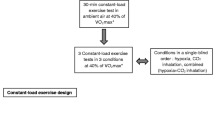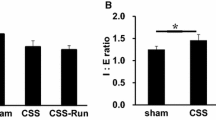Summary
The acute effect of inhaling the smoke of three cigarettes was compared to the effect of inhalation of an amount of carbon monoxide (CO), giving the same CO-saturation of the arterial blood as smoking during rest and during maximal exercise on a Krogh cycle ergometer. Sixteen male subjects were tested in the morning (1) after about 8 h without smoking (control), (2) after inhalation of the smoke of three cigarettes (smoke), and (3) after CO-inhalation (CO). It was found that the average maximal rate of O2-uptake (\(\dot V_{O_2 } \) max) decreased during both smoke and CO by about 7%. Endurance time at \(\dot V_{O_2 } \) max decreased 20% during smoke but only 10% during CO. A significant decrease in maximal heart rate (HR), and an increase in HR at rest, was demonstrated only during smoke. The peak lactate concentration (HLa) following maximal exercise was significantly decreased after smoke. The results suggest that the decrease in \(\dot V_{O_2 } \) max during smoke is due to the CO-saturation of the blood, and hence to a decrease in the oxygen capacity of the blood, while the decrease in endurance time during smoke is a combined effect of the CO-saturation and an increased cost of breathing caused by the smoke particles. It is further suggested that nicotine, or possibly some other components of the smoke, have an enhancing effect on the heart at rest, while an inhibition is seen during maximal exercise. Finally it was found that the subjects who had a \(\dot V_{O_2 } \) max above the average for all subjects investigated were less susceptible to the effects of smoking than subjects with a \(\dot V_{O_2 } \) max below the average.
Similar content being viewed by others

References
Behr MJ, Leong Ka-Hei, Jones RH (1981) Acute effects of cigarette smoking on left ventricular function at rest and exercise. Med Sci Sports Exerc 13: 9–12
Burn JH (1960) Action of nicotine on the heart. Ann NY Acad Sci 90: 70–73
Clarke BG, Guyatt AK, Alpers JH, Fletcher CM, Hill ID (1970) Changes in airway conductance on smoking a cigarette. Thorax 25: 418–422
Coffman JD, Javett SL (1963) Blood flow in the human calf during tobacco smoking. Circulation 28: 932–937
Goldbarg AN, Krone RJ, Resnekov L (1971) Effects of cigarette smoking on hemodynamics at rest and during exercise. I. Normal subjects. Chest 60: 531–536
Irving DW, Yamamoto T (1963) Cigarette smoking and cardiac Output. Br Heart J 25: 126–132
Karpovich PV, Hale CJ (1951) Tobacco smoking and physical performance. J Appl Physiol 3: 616–621
Kensler JC (1960) Compounds of pharmacological interest in tobacco smoke. Ann NY Acad Sci 90: 43–47
Kerrigan R, Jain AC, Doyle JT (1968) The circulatory response to cigarette smoking at rest and after exercise. Am J Med Sci 225: 113–119
Krone RJ, Goldbarg AN, Balkoura M, Schuessler R, Resnekov L (1972) Effects of cigarette smoking at rest and during exercise. II. Role of venous return. J Appl Physiol 32: 745–748
Mollerup P (1974) Tobaksrygnings momentane effekt på den menneskelige organisme. Tidsskr f LegemsØv 5: 133–139
Moses DC, Powers D, Soloff LA (1964) Glucose blockage of the increase in stroke volume produced by smoking. Circulation 29: 820–824
Nadel JA, Comroe JH (1961) Acute effects of inhalation of cigarette smoke on airway conductance. J Appl Physiol 16: 713–716
Nielsen B (1971) Thermoregulation during work in carbon monoxide poisoning. Acta Physiol Scand 82: 98–106
Rottenstein H, Peirce G, Russ E, Felder D, Montgomery H (1960) Influence of nicotine on the blood flow of resting skeletal muscle and of the digits in normal subjects. Ann NY Acad Sci 90: 102–113
Author information
Authors and Affiliations
Additional information
Supported by a grant from The Danish Sports Research Council
Rights and permissions
About this article
Cite this article
Klausen, K., Andersen, C. & Nandrup, S. Acute effects of cigarette smoking and inhalation of carbon monoxide during maximal exercise. Europ. J. Appl. Physiol. 51, 371–379 (1983). https://doi.org/10.1007/BF00429074
Accepted:
Issue Date:
DOI: https://doi.org/10.1007/BF00429074



